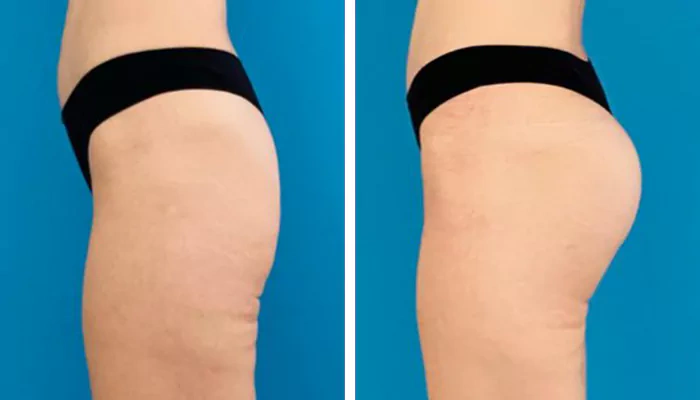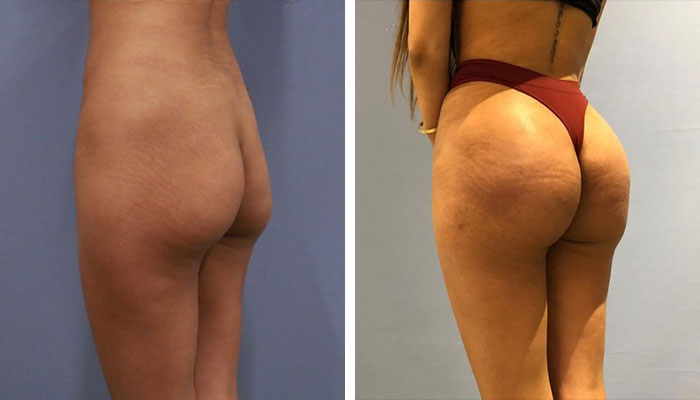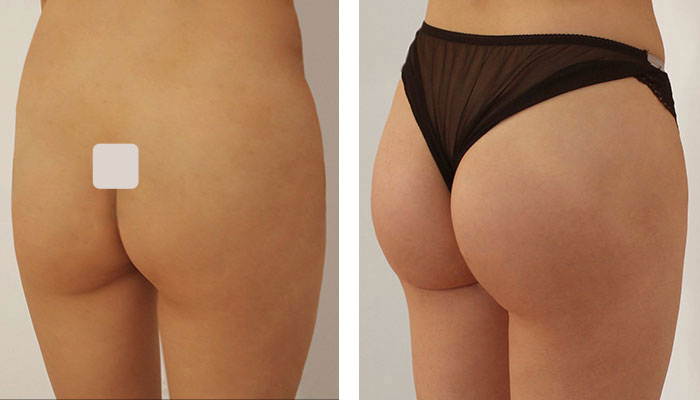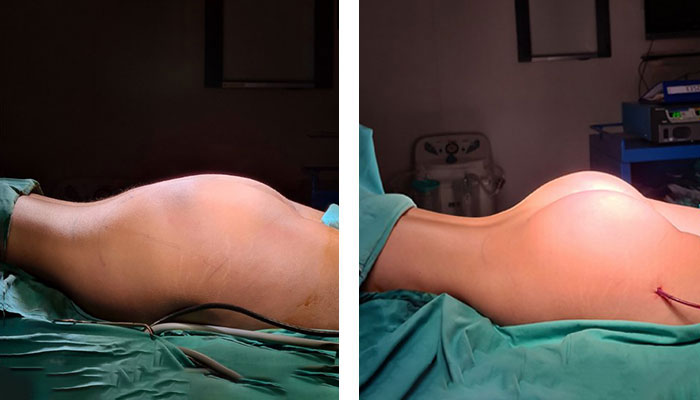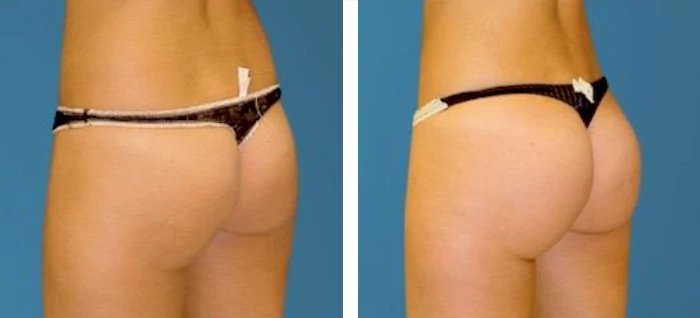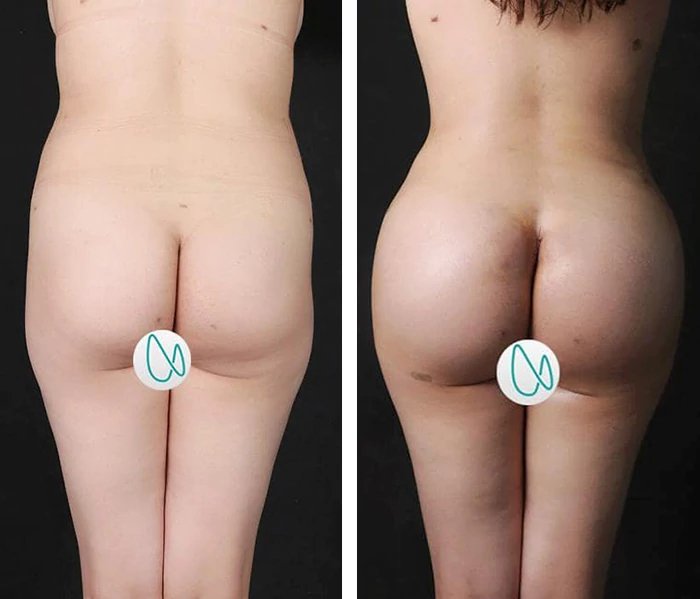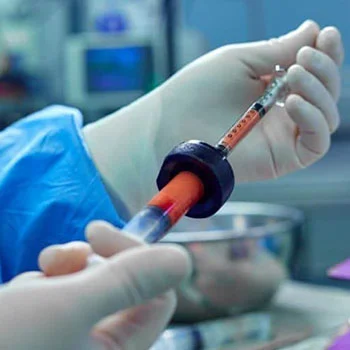What are butt implants?
Buttock implants or butt implants, also known as gluteal implants, are a butt augmentation procedure that involves placing silicone implants into the buttocks to enhance their size and shape. This procedure is usually done to create a fuller and rounder appearance of the buttocks. The implants come in various shapes and sizes to cater to individual preferences and goals. Butt implant surgery involves making incisions in the buttock crease, creating a pocket in the gluteal muscles, and inserting the implants to achieve the desired contour.
Who are good candidates for butt implants and who aren’t?
Good candidates for butt implants are individuals who are in good physical and mental health, have realistic expectations about the outcome of the surgery, and are looking to enhance the size and shape of their buttocks. Ideal candidates should also have enough fat or tissue in the buttock area to cover and support the implants.
On the other hand, individuals who are not suitable candidates for butt implants include those with underlying medical conditions that may increase the risks of surgery, a history of poor wound healing, or unrealistic expectations about the outcome of the surgery. Additionally, individuals who are unwilling to follow post-operative care instructions or those with a history of body dysmorphic disorder may not be ideal candidates for butt implants. It is important to consult with a board-certified plastic surgeon to determine if you are a suitable candidate for butt implant surgery.
How to prepare for butt implant surgery
Preparing for buttock implant surgery involves several steps to ensure a successful outcome and smooth recovery. Here are some general guidelines to help you prepare for butt implant surgery:
- Consultation: Schedule a consultation with a board-certified plastic surgeon to discuss your goals, medical history, and any concerns you may have about the surgery.
- Medical evaluation: Undergo a thorough medical evaluation to assess your overall health and fitness for surgery. Your surgeon may order blood tests, ECG, and other tests as necessary.
- Stop smoking and avoid certain medications: Quit smoking and avoid medications like aspirin, NSAIDs, and herbal supplements that can increase the risk of bleeding during surgery.
- Follow pre-operative instructions: Follow your surgeon's pre-operative instructions, which may include fasting before surgery, avoiding certain medications, and arranging for transportation to and from the surgical facility.
- Arrange for post-operative care: Plan for someone to assist you during the initial days of recovery, as you may need help with daily activities.
- Prepare your recovery space: Set up a comfortable recovery space at home with necessary supplies such as loose clothing, pillows, and medications prescribed by your surgeon.
- Stay hydrated and eat a healthy diet: Maintain a healthy diet and stay hydrated in the days leading up to surgery to promote optimal healing.
- Mental preparation: Mentally prepare yourself for the surgery and discuss any concerns or anxieties with your surgeon or a mental health professional if needed.
Following these guidelines and communicating openly with your surgeon can help you prepare effectively for butt implant surgery and achieve the best possible results.
Butt implants procedure steps
The buttock augmentation with implants typically involves the following steps:
- Anesthesia: The surgery is performed under general anesthesia to ensure the patient is comfortable and pain-free throughout the procedure.
- Incision: The plastic surgeon will make an incision in the buttock crease where the scar can be well hidden. Another common incision location is in the area where the cheek meets the back of the thigh.
- Implant placement: The silicone implants are carefully inserted into pockets created within the gluteal muscles or under the muscle, depending on the surgeon's technique and the patient's anatomy.
- Closure: Once the implants are in place, the incisions are closed with sutures. The surgeon may place drains to prevent fluid buildup and reduce the risk of infection.
- Recovery: After the surgery, the patient will be monitored in a recovery area before being discharged. Instructions on post-operative care, including activity restrictions, pain management, and follow-up appointments, will be provided.
It is essential to choose a skilled and experienced board-certified plastic surgeon to perform butt implant surgery and follow all pre-operative and post-operative instructions carefully to promote a smooth recovery and achieve the desired outcome.
What are different butt implant placement techniques?
There are three primary types of butt implant placement techniques commonly used in buttock augmentation surgery:
- Submuscular placement: In submuscular placement, the buttock implants are placed beneath the gluteal muscle but above the pelvic bone. This technique provides additional soft tissue coverage and support for the implants, potentially reducing the risk of implant visibility and palpability.
- Intramuscular placement: In this technique, the butt implants are placed within the gluteal muscle (intramuscularly). The implants are positioned between the layers of the gluteal muscles to create a more natural look and feel. Intramuscular placement can help reduce the risk of implant visibility or palpability while providing a more secure position for the implants within the muscle tissue.
- Subfascial placement: Subfascial placement involves positioning the butt implants above the gluteal muscle but beneath the fascia, a layer of connective tissue that covers the muscles. This technique allows for a more superficial placement of the implants, providing additional soft tissue coverage compared to intramuscular placement. Subfascial placement may be preferred for patients with limited muscle tissue or specific anatomical considerations.
The choice of implant placement technique depends on individual anatomy, the desired outcome, and the surgeon's expertise. During a consultation with a board-certified plastic surgeon, patients can discuss the available options, including implant placement techniques, to determine the most suitable approach for achieving their aesthetic goals in buttock augmentation surgery.
Butt implant sizes
Butt implants come in a variety of sizes to cater to individual preferences and desired outcomes. The sizes of buttock implants are typically measured in volume (cubic centimeters or cc). The specific size of butt implants chosen for a patient will depend on factors such as their existing buttock size, body shape, and aesthetic goals.
Common sizes of butt implants range from approximately 200cc to 600cc or more. During a consultation with a board-certified plastic surgeon, patients can discuss their desired outcome and preferences for buttock size to determine the most suitable implant size. The surgeon will consider factors such as the patient's anatomy, tissue elasticity, and desired projection to recommend an appropriate implant size that aligns with the patient's goals while ensuring a natural-looking result.
Patients should have a thorough discussion with their surgeon about the available implant sizes, the expected outcomes, and any limitations or considerations specific to their individual anatomy and goals before proceeding with butt implant surgery.
What’s the recovery like?
The recovery process after buttock implant surgery is crucial for achieving optimal results and minimizing complications. Here are some general guidelines for the recovery period:
- Patients may experience swelling, bruising, and discomfort in the first few days after surgery.
- Pain medication and antibiotics prescribed by the surgeon should be taken as directed.
- Patients are advised to rest and avoid strenuous activities during the initial recovery phase.
- Avoid sitting directly on the buttocks for the first few weeks to allow the implants to settle and reduce pressure on the surgical area.
- Patients may need to sleep on their stomach or side to avoid pressure on the buttocks.
- Light walking is encouraged to promote circulation and prevent blood clots, but strenuous exercise should be avoided.
- Patients may be required to wear compression garments to reduce swelling and support the surgical area.
- Follow the surgeon's instructions on when and how long to wear the compression garments.
- Patients should attend all scheduled follow-up appointments with their surgeon to monitor healing progress and address any concerns.
- The surgeon may remove drains, check incisions, and provide further instructions during these appointments.
- Maintain a healthy diet rich in nutrients to support healing and avoid foods that may cause constipation.
- Stay hydrated to promote healing and prevent complications.
- Smoking and alcohol consumption can interfere with the healing process and increase the risk of complications. It is recommended to avoid them during the recovery period.
- It is essential to be patient during the recovery period and follow all post-operative instructions provided by the surgeon.
- Practice self-care, including proper wound care, maintaining a positive mindset, and seeking support if needed.
By following these guidelines and closely adhering to the surgeon's recommendations, patients can promote a smooth recovery and achieve the best possible results after butt implant surgery.
How to sit after butt implants?
After butt implant surgery, sitting may initially feel uncomfortable due to swelling, tightness, and sensitivity in the buttock area. Patients are typically advised to avoid prolonged sitting or pressure on the buttocks during the initial recovery period, which can help minimize discomfort and promote proper healing. Using a cushion or pillow to support the thighs rather than directly sitting on the implants may also help reduce pressure on the surgical area. As the healing progresses, most patients gradually regain the ability to sit more comfortably.
Risks and possible complications of butt implants
Butt implant surgery, like any surgical procedure, carries risks and potential complications. Some of the risks and complications associated with butt implants include:
- Infection: There is a risk of infection at the surgical site, which can lead to complications and may require antibiotic treatment or implant removal.
- Implant shifting: Butt implants may shift from their original placement, causing asymmetry or an unnatural appearance that may require revision surgery.
- Capsular contracture: The formation of scar tissue around the implant (capsular contracture) can lead to firmness, pain, and distortion of the buttocks.
- Implant rupture or leakage: Although rare, silicone implants can rupture or leak, leading to changes in the shape and feel of the buttocks.
- Seroma: Fluid accumulation (seroma) around the implant site can occur, causing swelling and discomfort that may require drainage.
- Hematoma: Collection of blood (hematoma) at the surgical site can lead to pain, swelling, and potential complications if not addressed promptly.
- Nerve damage: There is a risk of nerve damage during surgery, leading to altered sensation, numbness, or tingling in the buttocks.
- Poor wound healing: Some patients may experience delayed wound healing, scarring, or wound separation, which may require additional treatment.
- Implant palpability or visibility: In some cases, the implant edges may be visible or palpable, leading to an unnatural appearance of the buttocks.
- Cosmetic dissatisfaction: Despite careful planning, there is a possibility of not achieving the desired cosmetic outcome, leading to dissatisfaction with the results.
It is essential for patients to discuss these risks and potential complications with their plastic surgeon before undergoing butt implant surgery. Choosing a board-certified plastic surgeon experienced in buttock augmentation can help minimize risks and optimize the likelihood of a successful outcome. Close adherence to pre-operative and post-operative instructions is crucial in reducing the risk of complications and promoting a smooth recovery.
How much does butt implant surgery cost?
The cost of butt implants can vary depending on several factors, including the surgeon's experience, geographic location, facility fees, anesthesia fees, implant type, and pre- and post-operative care. On average, the cost of butt implant surgery in the United States ranges from $5,000 to $15,000 or more.It is important to note that the total cost of butt implant surgery may include the following components:
- Surgeon's fee: This fee covers the surgeon's expertise, experience, and time spent performing the procedure.
- Anesthesia fee: The cost of anesthesia administered during the surgery.
- Facility fee: Charges for using the surgical facility, including operating room fees and nursing staff.
- Implant cost: The price of the silicone implants used for buttock augmentation.
- Pre-operative tests and consultations: Costs associated with medical evaluations, pre-operative tests, and consultations with the surgeon.
- Post-operative care: Expenses related to follow-up appointments, medications, and post-operative garments.
It is essential to consult with a board-certified plastic surgeon to obtain an accurate cost estimate for butt implant surgery based on your individual needs and goals. Additionally, patients should inquire about financing options, payment plans, and whether the procedure may be covered by insurance under certain circumstances.
Butt implants vs. BBL: which is better?
Butt implants and Brazilian butt lift (BBL) are both buttock augmentation techniques aimed at enhancing the size and shape of the buttocks to achieve a more aesthetically pleasing appearance. While butt implants involve the surgical placement of silicone implants, BBL utilizes the patient's own fat harvested through liposuction for buttock augmentation. Both procedures require anesthesia, incisions, and post-operative care to ensure optimal results and minimize complications. Butt implants offer a more predictable outcome in terms of size and shape customization, while BBL results may vary based on factors like fat survival and surgical technique.
In terms of safety, Brazilian butt lift is generally considered safer than butt implant surgery. This is primarily because BBL utilizes the patient's own fat harvested through liposuction for buttock augmentation, reducing the risk of implant-related complications associated with buttock implants. Additionally, BBL is a less invasive procedure compared to buttock implant surgery, which can lead to a potentially lower risk of surgical complications.
Determining whether butt implants or a Brazilian butt lift is right for you depends on various factors, including your aesthetic goals, body type, medical history, and preferences, but to give you a general idea, you may be a better candidate for one of the options if you meet the following criteria.
Butt implants
- Seeking a significant increase in buttock size and projection
- Looking for a more predictable outcome in terms of size and shape
- Have limited donor fat for a BBL procedure
- Have a willingness to undergo surgery and accept associated risks
- Have the ability to follow post-operative care instructions for a longer recovery period
- Have a desire for long-lasting results
Brazilian butt lift (BBL)
- Looking for a more natural enhancement using your own fat
- Are interested in body contouring through liposuction in addition to buttock enhancement
- Have excess fat in donor areas for fat transfer
- Have realistic expectations regarding fat absorption and the potential need for touch-up procedures
- Have a willingness to undergo liposuction and fat transfer procedures
- Have the ability to maintain a stable weight for optimal results
FAQs
Are butt implants permanent? How do they last?
The longevity of butt implants can vary for each individual and is influenced by factors such as implant quality, lifestyle choices, weight fluctuations, and the natural aging process. Generally, buttock implants are designed to be durable and long-lasting, with many patients enjoying results for ten years or more. However, over time, the buttocks may naturally change in shape and size, potentially affecting the appearance of the implants.
Will butt implant surgery leave visible scars?
Buttock implant surgery involves incisions to insert the implants, which can result in scarring. The visibility of scars will depend on factors such as incision placement, individual healing process, and post-operative care. Surgeons typically strive to place incisions in discreet locations, such as within the natural creases of the buttocks, to minimize the visibility of scars.
How does it feel to sit with butt implants?
After butt implant surgery, patients may experience some initial discomfort or tightness when sitting due to the presence of implants in the buttocks. Over time, as the body heals and adjusts to the implants, most patients report feeling more comfortable sitting.
How long does butt implant surgery take?
The duration of butt implant surgery can vary depending on the specific surgical technique, the complexity of the procedure, and any additional procedures performed simultaneously. On average, butt implant surgery typically takes around 2 to 3 hours to complete.
Do saline butt implants exist?
Saline butt implants are not commonly used for buttock augmentation. The most common type of implants used for buttock augmentation are silicone implants. Silicone implants are preferred over saline implants for buttock augmentation because they provide a more natural look and feel. Additionally, silicone implants are less likely to ripple or deflate compared to saline implants.
How to choose the right butt implant size?
Choosing the right buttock implant size is a crucial decision that should be made in consultation with your plastic surgeon. Factors to consider include your body proportions, desired aesthetic outcome, skin elasticity, and the surgeon's recommendations. During the consultation, your surgeon will assess your anatomy, discuss your goals, and provide recommendations based on your unique characteristics to help you achieve natural-looking and proportionate results.
How soon after butt implant surgery will I be able to exercise?
The timing for resuming exercise after buttock implant surgery varies for each patient and depends on the individual's healing progress. In general, patients are advised to avoid strenuous activities, including exercise, for at least 4-6 weeks following surgery to allow for proper healing of the implant pockets and incisions. Your surgeon will provide specific guidelines on when it is safe to gradually reintroduce exercise into your routine based on your recovery progress and surgical outcomes.
What happens if a butt implant ruptures?
If a butt implant ruptures, it can lead to changes in the shape, size, or feel of the buttocks. Symptoms of a ruptured implant may include pain, asymmetry, changes in contour, or visible deformities. In the case of a rupture, surgical removal and replacement of the implant are typically recommended. It is important to consult with your plastic surgeon promptly if you suspect a rupture to discuss treatment options and address any concerns.
Can I get my butt implants removed?
Yes, it is possible to have buttock implants removed through a surgical procedure known as implant removal or explantation. Reasons for implant removal may include changes in aesthetic preferences, complications, or the desire to reverse the augmentation. During the removal procedure, the implants are extracted, and the buttock tissues are reshaped to achieve the desired contour.

